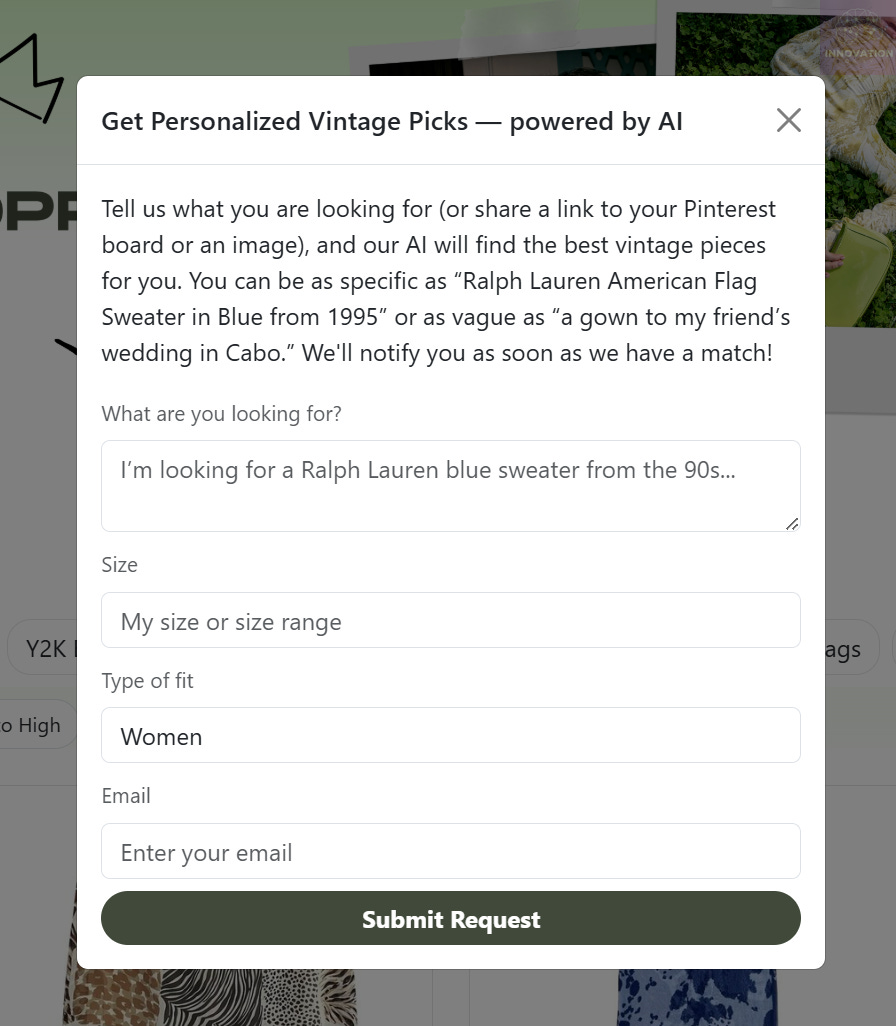Find Your Own Style
Who said vintage shopping can't be modern?
Project Overview
A few days ago, Y Combinator held its latest Demo Day, and according to TechCrunch, today's featured startup—Retrofit—made it onto the list of the 10 most promising startups of this cohort.
Retrofit is a vintage clothing marketplace with the tagline, "No need to search too hard" because its AI-powered system does the heavy lifting of curating selections for users.
The platform aggregates vintage fashion from multiple stores, allowing customers to browse and purchase directly on the website. When an order is placed, Retrofit handles payment processing, deducting a commission before transferring funds to the seller, and even arranges delivery. Returns are also processed through Retrofit, making the experience seamless.
Beyond partnering with stores, Retrofit enables individual users to resell their vintage items through the platform.
It’s important to note that Retrofit specializes in vintage fashion, not just second-hand clothing. According to the startup, an item is considered vintage if it is at least 20 years old. Mass-market brands, even those over 20 years old, are excluded from the platform.
The marketplace interface is structured like a traditional e-commerce storefront, displaying a grid of product images with search filters for categories, sizes, and tags. These range from standard ones like "outerwear" or "corporate chic" to more creative ones like "make a statement" or "mysterious romance."
A dedicated section showcases complete outfit inspirations, featuring images of stylish individuals alongside similar clothing, shoes, and accessories available for purchase.
For users who can’t find what they’re looking for at a glance, Retrofit’s AI assistant allows them to submit requests describing their desired item. As soon as a match appears on the marketplace, the AI sends an email with links. Descriptions can be as specific as "a Ralph Lauren blue sweater from 1995 with an American flag design" or as open-ended as "a dress I can wear to my best friend’s wedding."
Naturally, the AI also refines the product recommendations based on users’ browsing history and past requests.
What’s the Gist?
The resale clothing market is growing three times faster than the overall apparel industry. By 2028, the second-hand clothing market is projected to reach $350 billion.
This surge is part of a broader shift toward second-hand shopping. In some countries, 50–60% of adults purchase at least one used item per year. The top markets for resale include the UK, US, France, Germany, Mexico, Brazil, and Spain.
In the US, apparel is the most popular category for second-hand shopping, followed by footwear. Handbags are also in high demand, though they rank slightly behind home appliances and home goods. Retrofit’s focus on clothing, shoes, and bags aligns well with these trends.
But why emphasize vintage over general second-hand apparel? While cost-saving is a major driver for buying pre-owned goods, it’s not the only factor.
A study by second-hand marketplace ThredUp identified four main buyer personas:
Gen Z (18–26 years old): They shop second-hand to express individuality and avoid mass-market fashion, but often lack the budget for high-end designer pieces.
Millennials (27–42 years old): They prioritize affordability to dress their families stylishly without breaking the bank.
Gen X (43–58 years old): They seek quality brands but prefer pre-owned luxury items to avoid overpaying for seasonal trends.
Baby Boomers (59+ years old): They shop for fun, enjoying the thrill of finding unique items at great prices.
Only one of these four groups is primarily driven by saving money—millennials shopping for their families. For everyone else, personal style comes first, and affordability is just a bonus.
Young consumers are the key drivers of this movement, with 40% of Gen Z buyers turning to second-hand fashion to define their style. This suggests the trend is here to stay.
Interestingly, Retrofit isn’t the only startup from this Y Combinator batch targeting the resale market. Encore, another marketplace, also leverages AI to help users find items. However, it didn’t make TechCrunch’s top 10 list—possibly due to its broader positioning as a general resale platform focused on affordability rather than curation. Another limitation? Unlike Retrofit, Encore doesn’t handle transactions directly; it merely redirects users to third-party sellers, making its business model less compelling.
Key Takeaways
For a long time, second-hand shopping was associated with frugality. But that perception is shifting, making it one of the biggest industry transformations happening right now.
Successful startups often thrive by capitalizing on change. As we know, all the old ideas have already been invented — what matters is responding quickly to evolving consumer behavior.
So where are the opportunities? The resale market presents a wide range of possibilities beyond just marketplaces.
Take Archive, for example. Instead of launching a marketplace, they built a platform that allows brands to create their own resale marketplaces, tapping into a new revenue stream that could account for 20–30% of total sales.
Then there’s Minimist, which developed an app to help thrift stores quickly catalog and list second-hand items online. The challenge? Digitizing inventory is time-consuming, and 93% of European thrift stores currently don’t sell online because of it.
Or consider Haz, an app that helps users catalog their wardrobe. Its standout feature? Automatic price tracking for resale, with built-in marketplace integration to facilitate quick sales.
If we circle back to marketplaces, the key differentiator will be AI-powered curation. A successful platform must go beyond simple search filters and offer personalized recommendations - something that’s both challenging and incredibly exciting.
Company info:
Retrofit
Website: retrofit.shop
Total investment: $500K, round: 1













